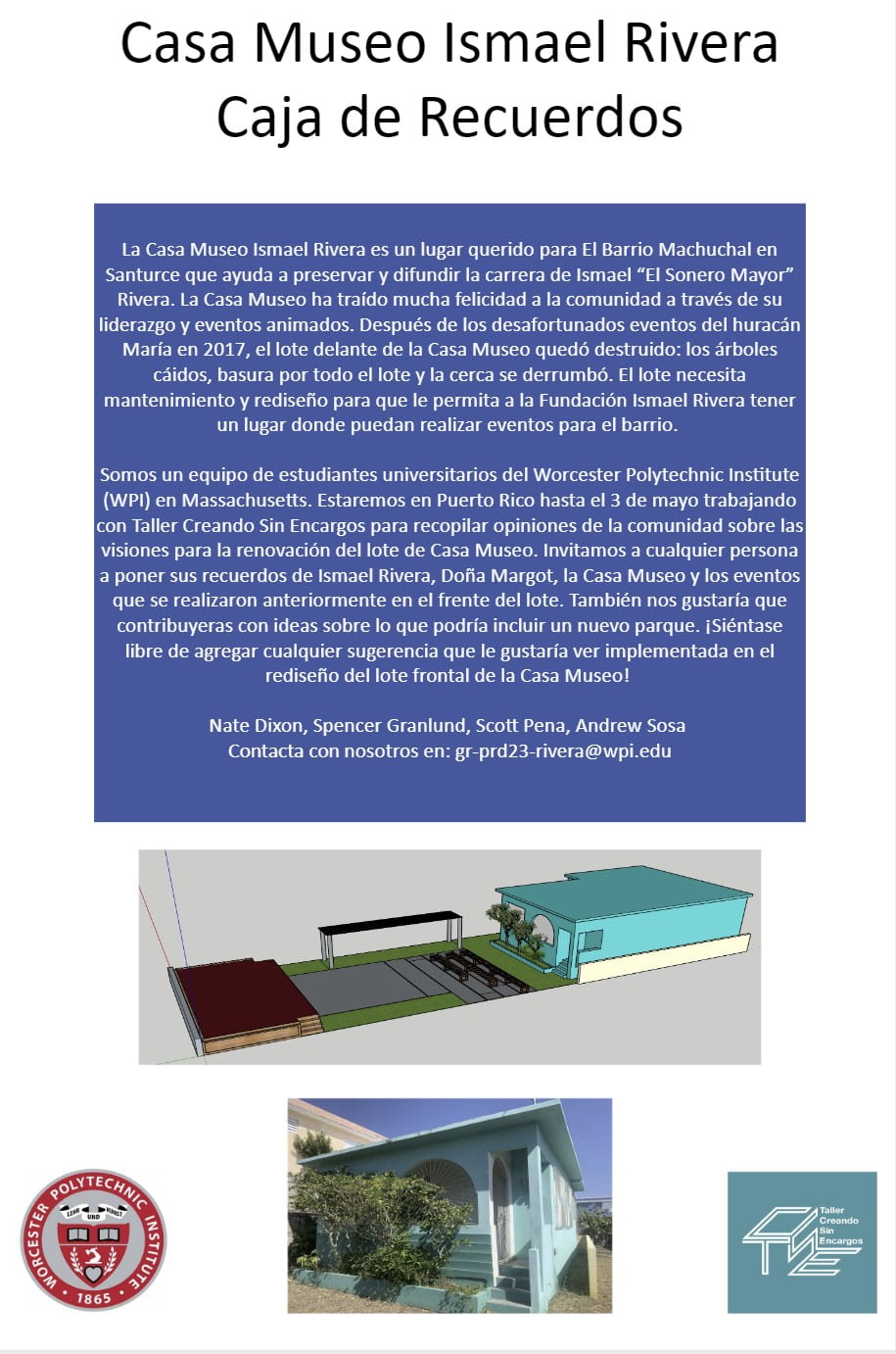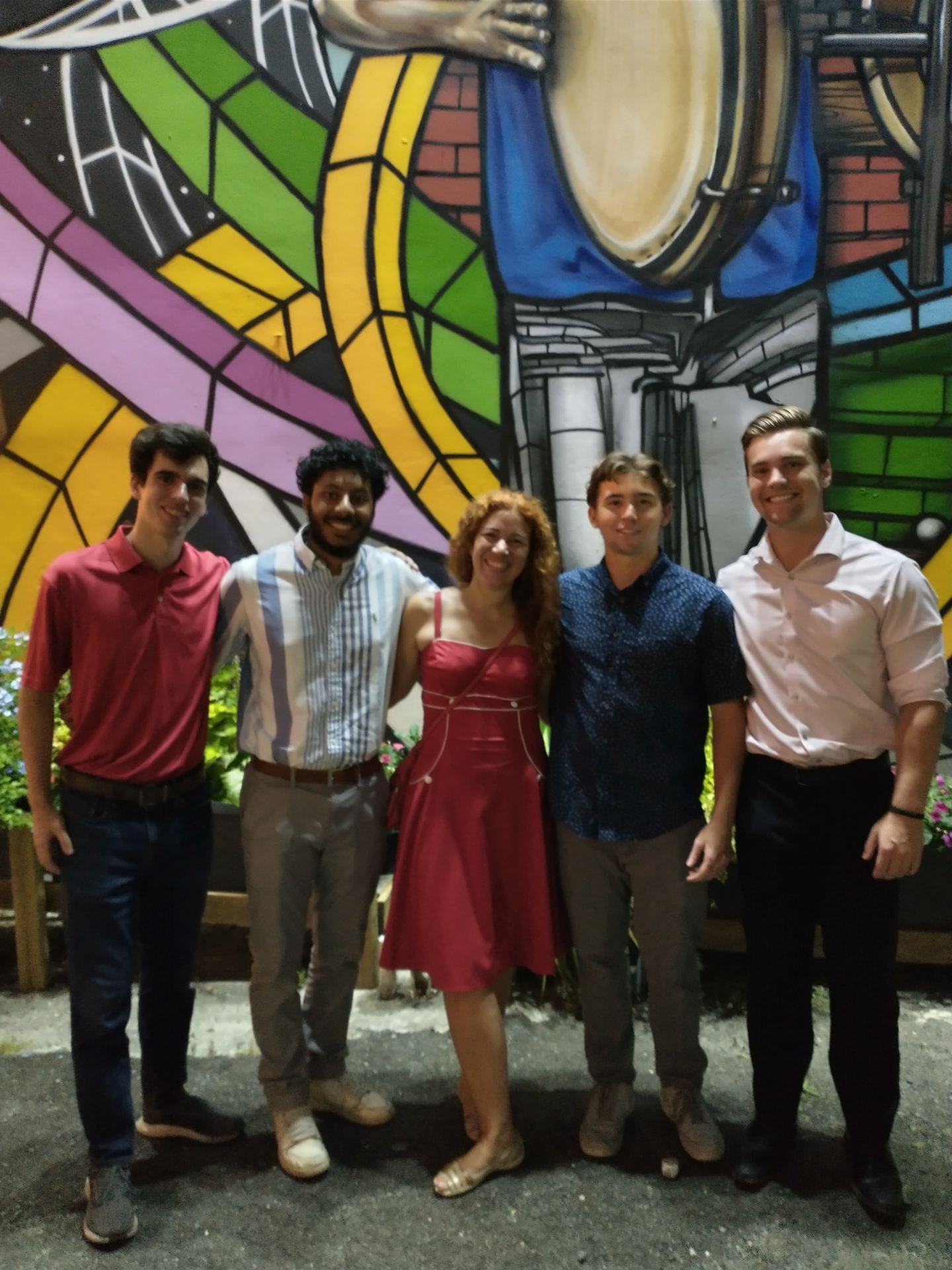Re-Designing the Casa Museo Ismael Rivera Park
Project Sponsor: Omayra Rivera Crespo, PhD
School of Architecture at the University of Puerto Rico
Team Members: Nate Dixon, Spencer Granlund, Scott Pena, Andrew Sosa
Project Advisors: Professors Leslie Dodson and Scott Jiusto
Project Files:
- WPI Casa Museo Rivera Full Project Report
- Final Presentation Casa Museo Ismael Rivera Spring 2023
- Casa Museo Participatory Design Tool Kit Spring 2023
- Casa Museo Ismael Rivera Pocket Park Design Portfolio Spring 2023
- Event Flyers Omayra edit
- Event Here Poster

- Visual Collage Poster

- Project Summary Poster

Abstract:
The Casa Museo Ismael Rivera is a ‘house museum’ that highlights the legacy of Ismael Rivera, a renowned salsa singer born in Santurce, Puerto Rico. The Casa Museo Ismael Rivera’s front yard hosted large community events to celebrate Ismael Rivera’s life and impact on Puerto Rican culture but was damaged during Hurricane Maria. Our project was to clean the front yard and to engage with the local community surrounding the Casa Museo Ismael Rivera using participatory design events to create visions for transforming the yard into a community pocket park. Through these participatory design activities, we created a portfolio displaying strong community-made park designs, a participatory design toolkit, and a cost estimation tool.
Executive Summary
Executive Summary
In the past, the Casa Museo Ismael Rivera held communal celebrations such as Las Fiestas de Cruz and Ismael Rivera’s birthday. These festivities helped unite Barrio Machuchal through cultural celebrations and events honoring what Ismael “Maelo” Rivera meant to the island (Fundación Rivera, 2020).
Since the destruction of Hurricane Maria in 2017, the yard has remained abandoned and unable to host neighborhood celebrations or help people remember Ismael Rivera. Over the past few years, the neighborhood has used the space as a parking lot, trash has piled up, and the land has become a walking hazard due to deep holes, tree roots, and elevated surfaces. The state of the yard has discouraged neighbors and visitors alike from embracing the Casa Museo and seeing its importance. If transformed into a “pocket park” or small-scale green space, however, the yard could contribute to Barrio Machuchal’s sense of community and safety. Not only would the park help bring the community together through celebrations, but it could also serve as a usable outdoor space for residents old and young, including those from the next-door nursery school.
On arrival in Puerto Rico, the IQP team had four main objectives; analyze the current Casa Museo Ismael Rivera Park conditions; use participatory design methods to involve the community; generate CAD drawings of all potential designs; and finally identify park design funding and maintenance costs.
To satisfy the first objective, the team traveled to the site and extensively mapped and photographed the current conditions of the Casa Museo. Then cleaned and removed all the overgrown vegetation and trash.
For objective two, we pursued three main phases of participatory design. Phase 1, the preparation period, focused on finalizing design activities and hosting a public design event at the Casa Museo to stimulate excitement within the community. Phase 2, participatory design, featured three participatory design activities. Phase 3 focused on finalizing designs using participant input, and meeting with stakeholders to gather feedback.
The third objective was satisfied simultaneously with the second by creating detailed CAD drawings of community-based designs. These designs are the key deliverables for the project.
The fourth objective was fulfilled by creating a cost estimation tool in Microsoft Excel.
Findings
The community that surrounds the Casa Museo Ismael Rivera provided powerful insight in participatory design sessions for pocket parks. We found:
- The Memory Box stimulated an emotional connection to this project.
- The Participatory Mapping activity was a gateway between the past and the future of the Casa Museo Pocket Park.
- The Image Ranking Activity invited participants to refine designs and imagine themselves in the future park.
- Design workshop engagement formed a bond between participants and facilitators through conversation.
- “One-on-One” Engagement strengthened relationships and vocalized deeper design ideas.
- Ivelisse Rivera, Ismael’s sister and founder of the Fundación Ismael Rivera, provided important historic context for this project.
- Mari, owner of Divino Niño Day Care, expressed the need for children’s features in the park.
- 3D Modeling potential park designs allowed us to fulfill the ideas of the community in a quick and visual way.
- Materials on the Casa Museo property continues Taller Creando Sin Encargos idea of reusing materials.
- Creating a Cost Estimate Tool simplifies the cost of a project and how to divide resources.
Outcomes & Deliverables
This project was successful in involving stakeholders and engaging the community in the design process. The three design activities and the input they gathered were used to create the two key deliverables of the project, The Casa Museo Ismael Rivera Pocket Park Design Portfolio, and the Participatory Design Toolkit.
The Participatory Design Toolkit highlights the strategies used in the project including the workshop formats that were followed. This document features detailed descriptions, procedures, images, materials, and findings regarding the participatory design activities. This step-by-step manual for participatory park design is meant for students, researchers, and community members interested in using participatory design. The toolkit is focused on the three main participatory design events used to engage the community and gather their insights and input on design options. Those three events are the Memory Box activity; the Participatory Park Mapping activity; and the Visual Ranking activity.
In addition to the physical deliverables, the project also achieved non-tangible outcomes that benefited the Casa Museo pocket park project. One such outcome is the promotion of the project within the community. This was done by handing out flyers, going door to door, and holding events.
Another outcome is the creation of a strong foundation for the project to continue in the future. Through the design portfolio and participatory design activities, the team was able to lay the groundwork for the Ismael Rivera Foundation to continue the project. Our design portfolio is meant to introduce the project and appeal to potential investors.
Recommendations
After completing the project and reflecting on the methodologies, our team has composed a list of recommendations to assist Casa Museo Park redevelopment in the future. These sets of recommendations will improve and streamline the following processes.
- Creating a Memory Box
- Planning a Participatory Design Event
- Recommendations for Running a Participatory Design Event
- Community Engagement
- Creating a CAD Model of a Potential Park Design











